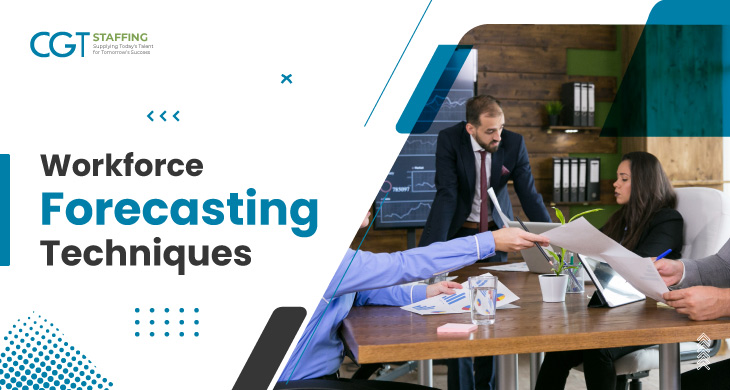Workforce forecasting estimates the number of people (and their skill sets) required by a company to meet its staffing needs. This includes workforce planning and forecasting for the next day, week, or even the year. Although companies want to have enough employees to meet the needs of their customers, it is also essential to not hire more than necessary.
Historically, workforce forecasting has been based on manual data analysis and is subject to human judgement. However, businesses now have powerful AI tools supporting workforce forecasting techniques.
Table of Contents
What Is Workforce Forecasting?
Workforce planning and forecasting is a scientific analysis of the workforce a company will need, the skill sets they render, and how these skills need to be applied for maximum efficiency. This forecasting is critical to ensuring that businesses have the right number of skilled employees with the appropriate competencies to meet their objectives. There are two main time criteria for such planning:
Operational Workforce Forecasting
Operational workforce forecasting is the short-term forecast for the next one to two years. It endeavors to formally outline the day-to-day business activities necessary to run the business.
Strategic Workforce Forecasting
This type focuses on the longer time frame, usually two to five years. It is a longer-term attempt at managing holistic staffing needs and aligning HR processes to business-wide goals.
The Evolution of Workforce Forecasting Techniques
Workforce forecasting has been a fundamental aspect of human resource management for decades. Initially, these techniques involved simple extrapolations from historical data and relied on basic statistical models. Over time, it evolved to include more complex methods, such as regression analysis and time-series forecasting. These workforce forecasting techniques allowed organizations to make more informed decisions about their workforce needs. However, as businesses grew larger and the data became more extensive, traditional methods began to show their limitations.
The Emergence of Artificial Intelligence in Workforce Forecasting
AI has definitely revolutionized the way businesses operate across various industries. In workforce forecasting, AI brings the potential to unlock hidden insights, analyze vast amounts of data rapidly, and make accurate predictions. Machine Learning algorithms can further help identify patterns and trends in historical workforce data. This allows more robust forecasting models. Organizations can significantly enhance their decision-making and optimize workforce planning by employing AI.
Benefits of AI in Workforce Forecasting
The use of AI in workforce forecasting offers several benefits. Just as with centralized recruitment, AI can help ensure fair hiring practices with equal opportunities through:
Enhanced Data Analysis
Artificial intelligence enables businesses to gather colossal amounts of data and analyze it. AI can identify patterns and outliers, which in turn allows companies to respond to potential risks or opportunities.
Real-Time Insights
In workforce forecasting, human resources can now act in real-time and make evidence-based decisions, which will help revolutionize staffing problems.
Reduced Bias
Humans shape their decisions based on unconscious bias at every level of an organization. Artificial intelligence helps reduce this bias, as the decisions generated by the models depend upon extensive data. In this fashion, the results will not be hinged on individual preferences.
Scalability
Instead of depending on small data, organizations can now depend on a comprehensive talent strategy to drive results. Through the use of artificial intelligence, companies can collect large amounts of data, organize and analyze it, and constitute to increase engagement and productivity.
AI can be implemented for workforce forecasting in any industry. From mortgage recruiters to nursing professionals, everyone can avail the benefits of artificial intelligence.
Precise Skill Gap Analysis
Conducting a skills gap analysis assists organizations in getting ready for changes and challenges ahead. By using artificial intelligence in workforce forecasting, companies can compare existing skills to those the company needs in the future to stay competitive in the market.
Challenges and Limitations of AI in Workforce Forecasting
Using AI-based workforce forecasting techniques comes with its disadvantages.
AI-Powered Talent Acquisition
AI-powered talent acquisition strategy may lead to emergent bias in the hiring process if algorithms are not adjusted to consider new forms of knowledge and excludes certain groups.
Additionally, it can lead to an overreliance on technology, which leads to an underestimation of human skills.
Data Privacy and Security
The major concern revolving around artificial intelligence is the potential for data breaches. There is a wealth of information being collected and processed. This comes with a huge risk of the data falling into the wrong hands and its potential misuse.
Overreliance on Historical Data
As artificial intelligence becomes ever more integrated into organizations, it is imperative that the model is trained according to the latest insights. The seminal problem with AI is that it is overly reliant on historical data and subsequently may not render accurate up-to-date information
Conclusion
Artificial intelligence can make workforce planning and forecasting more agile and accurate. By implementing forecasting techniques, organizations can now gain a competitive edge. While there are still some limitations and challenges to the use of AI, it will revolutionize human resource management, contributing to better productivity and efficient processes in the coming years.
